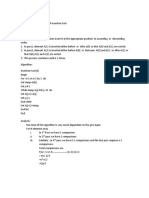0 ratings0% found this document useful (0 votes)
2 viewsUnit 3 Searching sorting
The document provides an overview of sorting and searching in data structures, explaining sorting as the arrangement of data for easier searching. It details various sorting algorithms, including selection sort, bubble sort, insertion sort, shell sort, and non-comparison-based sorting techniques like radix and counting sort. Additionally, it covers searching algorithms such as binary search (iterative and recursive), Fibonacci search, and indexed sequential search.
Uploaded by
sumeetCopyright
© © All Rights Reserved
Available Formats
Download as PDF, TXT or read online on Scribd
0 ratings0% found this document useful (0 votes)
2 viewsUnit 3 Searching sorting
The document provides an overview of sorting and searching in data structures, explaining sorting as the arrangement of data for easier searching. It details various sorting algorithms, including selection sort, bubble sort, insertion sort, shell sort, and non-comparison-based sorting techniques like radix and counting sort. Additionally, it covers searching algorithms such as binary search (iterative and recursive), Fibonacci search, and indexed sequential search.
Uploaded by
sumeetCopyright
© © All Rights Reserved
Available Formats
Download as PDF, TXT or read online on Scribd
You are on page 1/ 17
3.
Sorting and Searching
What is Sorting
• The arrangement of data in a preferred order is called sorting in the
data structure.
• By sorting data, it is easier to search through it quickly and easily.
• The simplest example of sorting is a dictionary. Before the era of the
Internet, when you wanted to look up a word in a dictionary, you
would do so in alphabetical order. This made it easy.
What is a Sorting Algorithm?
• A sorting algorithm is just a series of orders or instructions. In this, an
array is an input, on which the sorting algorithm performs operations
to give out a sorted array.
• Types of Sorting Techniques
• There are various sorting algorithms are used in data structures. The
following two types of sorting algorithms can be broadly classified:
• Comparison-based: We compare the elements in a comparison-based
sorting algorithm)
• Non-comparison-based: We do not compare the elements in a non-
comparison-based sorting algorithm)
•
Importance Of Sorting
• When you are performing sorting on elements, many complications
such as min/max, kth smallest/largest get automatically simplified.
• Sorting also provides you with many algorithmic solutions, some of
which might include divide and conquer, iterative, and recursive-
based.
• One of the biggest benefits of sorting in DSA is time complexity.
The ultimate goal is to solve any kind of complex problem within the
minimum amount of time. That is where different types of sorting in
data structure come into play. It not only saves up your very precious
time but also provides you with the right solution.
Sorting Categories
• There are two different categories in sorting:
• Internal sorting: If the input data is such that it can be adjusted in the
main memory at once, it is called internal sorting.
• External sorting: If the input data is such that it cannot be adjusted in
the memory entirely at once, it needs to be stored in a hard disk,
floppy disk, or any other storage device. This is called external sorting.
Selection Sort
• Algorithm Pseudo Code
• Step 1:- Initialize i=0 for i in range(a[]):
• Step 2:- Repeat step 3 to 5 until min_id = i
i<n for j in range(i + 1, a[]):
• Step 3:- j= i+1 if a[min_id] >a[j]:
• Step 4:- Repeat step 5 until j < n min_id = j
Step 5:- if a[min_id] >a[j] a[i], a[min_id] =
min_id = j a[min_id], a[i]
a[i], a[min_id] =
a[min_id], a[i]
• Step 6:- stop
Bubble Sort
• Algorithm Pseudo Code in C++
• Step 1:- Initialize i=0
• Step 2:- Repeat step 3 to 5 For (i=0; i<n; i++)
until i<n For ( j=0; j<n-i-1; j++)
• Step :- j=0 {
If If A[j]>a[j+1] then
• Step 4:- Repeat step 5 until j < {
n-i-1 temp= a[j]
• Step 5:- If A[j]>a[j+1] then A[j]=a[j+1]
temp= a[j] A[j+1]=a[j]
A[j]=a[j+1] }
}
A[j+1]=a[j]
• Step 6:- stop
Insertion Sort
• Algorithm Pseudo Code
• Step 1:- Initialize i=1 for i in range(1,len(arr)):
• Step 2:- Repeat step 3 to 5 temp = arr[i]
until i<n j=i-1
• Step 3:- temp=a[i] ; j= I -1 while (j >= 0) & (arr[j] >
• Step 4:- Repeat step 5 until temp):
j > = 0 and a[j]>temp arr[j + 1] = arr[j]
Step 5:- a[j+1] = a[j] j=j-1
j = j -1 arr[j + 1] = temp
a[j+1] = temp
Step 6:- stop
Shell Sort
• d = n // 2
• while d > 0:
• for i in range(d, n):
• temp = arr[i]
• j=i
• while j >= d and arr[j - d] > temp:
• arr[j] = arr[j - d]
• j -= d
• arr[j] = temp
• d = d // 2
Non Comparision Based Sorting
• Radix Sort Algorithm
• The key idea behind Radix Sort is to exploit the concept of place value. It assumes that sorting
numbers digit by digit will eventually result in a fully sorted list. Radix Sort can be performed
using different variations, such as Least Significant Digit (LSD) Radix Sort or Most Significant
Digit (MSD) Radix Sort.
• Step 1: Find the largest element in the array, If it has three digits, so we will
iterate three times, once for each significant place.
• Step 2: Sort the elements based on the unit place digits (X=0). We use a stable
sorting technique, such as counting sort, to sort the digits at each significant
place.
• Step 3: Sort the elements based on the tens place digits.
• Step 4: Sort the elements based on the hundreds place digits.
Counting Sort
• countingSort(array, n) // 'n' is the size of array
• max = find maximum element in the given array
• create count array with size maximum + 1
• Initialize count array with all 0's
• for i = 0 to n
• find the count of every unique element and
• store that count at ith position in the count array
• for j = 1 to max
• Now, find the cumulative sum and store it in count array
• for i = n to 1
• Restore the array elements
• Decrease the count of every restored element by 1
• end countingSort
Binary Search Iterative
Low = 0
High = n - 1
while Low <= High:
mid = (Low + High) // 2
if A[mid][0] < x:
Low = mid + 1
if A[mid][0] > x:
High = mid - 1
if A[mid][0] == x:
return mid
return -1
Binary Search Recursive
if Low < High:
mid = (High + Low) // 2
if A[mid][0] > x:
return Search.binary_search_recursive(A, x, mid, Low)
if A[mid][0] < x:
return Search.binary_search_recursive(A, x, High, mid)
else:
return mid
return -1
Fibonacci Search
Step 1:- Find F(k) (i.e. kth Fibonacci no) which is greater than or equal
to n
Step 2:- If F(k)=0; then stop and print message "no not found"
Step 3:- Offset = -1
Step 4:- i= min( offset + F(k-2), n-1)
Step 5:- If s==a[i]; return i and stop the search
If s > a[i]; k=k-1, offset=i and repeat step 4,5
If s<a[i] ; k=k-2 , offset = i and repeat step 4,5
Indexed Sequential Search
Step 1 : Read the search element from user
Step 2 : Divide the array into group according to the group size
Step 3 : Create index array that contains starting index of the group
Step 4 : If the group is present and the first element of that group
is less than or equal to key element go to next group
Else apply linear search in previous group
You might also like
- Davis Whitney How To Make Analogies DigitalNo ratings yetDavis Whitney How To Make Analogies Digital29 pages
- Sorting Concepts: of Study in Computer ScienceNo ratings yetSorting Concepts: of Study in Computer Science13 pages
- DSAL-211-Lecture 6 - Sorting AlgorithmsNo ratings yetDSAL-211-Lecture 6 - Sorting Algorithms27 pages
- DSU Practicals Manual Writing Material-All Titles.No ratings yetDSU Practicals Manual Writing Material-All Titles.24 pages
- Chapter 2-Simple Searching and Sorting Algorithms100% (1)Chapter 2-Simple Searching and Sorting Algorithms21 pages
- Simple Searching and Sorting (Slide) (1)No ratings yetSimple Searching and Sorting (Slide) (1)38 pages
- Sorting and Algorithm Analysis: Computer Science E-119 Harvard Extension School Fall 2012 David G. Sullivan, PH.DNo ratings yetSorting and Algorithm Analysis: Computer Science E-119 Harvard Extension School Fall 2012 David G. Sullivan, PH.D39 pages
- Data Structure and Algorithm Unit 6 Sorting and Hashing100% (1)Data Structure and Algorithm Unit 6 Sorting and Hashing41 pages
- Simple Sorting and Searching Algorithms 2.1searching: PseudocodeNo ratings yetSimple Sorting and Searching Algorithms 2.1searching: Pseudocode7 pages
- Design and an.alysis Algo Chapter 2 AllNo ratings yetDesign and an.alysis Algo Chapter 2 All34 pages
- Selection, Insertion and Bubble SortingNo ratings yetSelection, Insertion and Bubble Sorting21 pages
- DSAL-211-Lecture 5 - Sorting AlgorithmsNo ratings yetDSAL-211-Lecture 5 - Sorting Algorithms30 pages
- A0056006120-Audi A6 Suspension Service Manual - Running Gear Front-Wheel Drive and Four-Wheel Drive100% (1)A0056006120-Audi A6 Suspension Service Manual - Running Gear Front-Wheel Drive and Four-Wheel Drive468 pages
- Call for Papers_BSA_Vienna_2025_Bourdieu_finaleNo ratings yetCall for Papers_BSA_Vienna_2025_Bourdieu_finale4 pages
- Lag, Lead, Lead-Lag - Compensation in Control System100% (2)Lag, Lead, Lead-Lag - Compensation in Control System11 pages
- [Ebooks PDF] download Brain-Computer Interfaces (Volume 168) (Handbook of Clinical Neurology, Volume 168) 1st Edition Michael J. Aminoff full chapters100% (2)[Ebooks PDF] download Brain-Computer Interfaces (Volume 168) (Handbook of Clinical Neurology, Volume 168) 1st Edition Michael J. Aminoff full chapters51 pages
- Flyer Rosemount Wireless Permasense Corrosion Erosion Monitoring System For Refineries en 5390998No ratings yetFlyer Rosemount Wireless Permasense Corrosion Erosion Monitoring System For Refineries en 53909982 pages
- Competitive Strategy Within Engineering Management (2533)No ratings yetCompetitive Strategy Within Engineering Management (2533)7 pages
- Method Acting Reconsidered Theory Practice Future 1st Ed 978 0 312 22309 0978 1 349 62271 9No ratings yetMethod Acting Reconsidered Theory Practice Future 1st Ed 978 0 312 22309 0978 1 349 62271 9302 pages
- IOM Presnetation GCT, Mianwali 30-01-2019 2100% (2)IOM Presnetation GCT, Mianwali 30-01-2019 242 pages
- Mitsubishi Electric Heat Pump Parts Indoor MSZ-GE22-50VA-A1 PDFNo ratings yetMitsubishi Electric Heat Pump Parts Indoor MSZ-GE22-50VA-A1 PDF8 pages
- Penjelasan Project SIK - 2022-2023 GasalNo ratings yetPenjelasan Project SIK - 2022-2023 Gasal5 pages
- How To Add, Subtract, Multiply, Divide in ExcelNo ratings yetHow To Add, Subtract, Multiply, Divide in Excel6 pages
- Specification FOR Saw, Plaster, Hand: Re Sffirrmd 191100% (1)Specification FOR Saw, Plaster, Hand: Re Sffirrmd 1912 pages
- DSU Practicals Manual Writing Material-All Titles.DSU Practicals Manual Writing Material-All Titles.
- Sorting and Algorithm Analysis: Computer Science E-119 Harvard Extension School Fall 2012 David G. Sullivan, PH.DSorting and Algorithm Analysis: Computer Science E-119 Harvard Extension School Fall 2012 David G. Sullivan, PH.D
- Data Structure and Algorithm Unit 6 Sorting and HashingData Structure and Algorithm Unit 6 Sorting and Hashing
- Simple Sorting and Searching Algorithms 2.1searching: PseudocodeSimple Sorting and Searching Algorithms 2.1searching: Pseudocode
- Advanced C Concepts and Programming: First EditionFrom EverandAdvanced C Concepts and Programming: First Edition
- A0056006120-Audi A6 Suspension Service Manual - Running Gear Front-Wheel Drive and Four-Wheel DriveA0056006120-Audi A6 Suspension Service Manual - Running Gear Front-Wheel Drive and Four-Wheel Drive
- Lag, Lead, Lead-Lag - Compensation in Control SystemLag, Lead, Lead-Lag - Compensation in Control System
- [Ebooks PDF] download Brain-Computer Interfaces (Volume 168) (Handbook of Clinical Neurology, Volume 168) 1st Edition Michael J. Aminoff full chapters[Ebooks PDF] download Brain-Computer Interfaces (Volume 168) (Handbook of Clinical Neurology, Volume 168) 1st Edition Michael J. Aminoff full chapters
- Flyer Rosemount Wireless Permasense Corrosion Erosion Monitoring System For Refineries en 5390998Flyer Rosemount Wireless Permasense Corrosion Erosion Monitoring System For Refineries en 5390998
- Competitive Strategy Within Engineering Management (2533)Competitive Strategy Within Engineering Management (2533)
- Method Acting Reconsidered Theory Practice Future 1st Ed 978 0 312 22309 0978 1 349 62271 9Method Acting Reconsidered Theory Practice Future 1st Ed 978 0 312 22309 0978 1 349 62271 9
- Mitsubishi Electric Heat Pump Parts Indoor MSZ-GE22-50VA-A1 PDFMitsubishi Electric Heat Pump Parts Indoor MSZ-GE22-50VA-A1 PDF
- Specification FOR Saw, Plaster, Hand: Re Sffirrmd 191Specification FOR Saw, Plaster, Hand: Re Sffirrmd 191

























































































